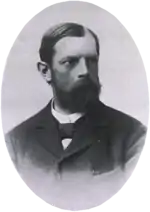Hans Ernst August Buchner
Hans Ernst August Buchner (16 December 1850 – 5 April 1902) was a German bacteriologist who was born and raised in Munich. He was the older brother of Eduard Buchner (1860–1917), winner of the 1907 Nobel Prize in Chemistry.
Hans Buchner | |
|---|---|
 Hans Ernst August Buchner | |
| Born | 16 December 1850 |
| Died | 5 April 1902 (aged 51) Munich, German Empire |
| Nationality | Germany |
| Alma mater | University of Leipzig |
| Known for | Discovering complement Work on Gamma globulin Study of Anaerobic organisms |
| Scientific career | |
| Institutions | Munich University |
Biography
He studied medicine in Munich and Leipzig, earning his MD from the University of Leipzig in 1874. Afterwards he served as a physician in the Bavarian Army. In 1880 be became a lecturer at the University of Munich, where in 1894 he succeeded Max von Pettenkofer (1818–1901) as professor and director of the institute of hygiene.[1] At Munich, he was an associate of Max von Gruber (1853–1927).
Hans Buchner was a pioneer in the field of immunology. He was the first to discover a substance in blood serum that was capable of destroying bacteria. He called the substance "alexin", which was later named "complement" by Paul Ehrlich (1854–1915).[1]
In 1888 he introduced the pyrogallic method for cultivation of anaerobic bacteria.[2][3] Along with Martin Hahn, he assisted his brother, Eduard Buchner, with the isolation of zymase. Their findings were published in a 1903 treatise titled "Die Zymasegärung" (Zymase fermentation).[4]
Selected writings
- Die ätiologische Therapie und Prophylaxe der Lungentuberculose. (Aetiological therapy and prophylaxis involving lung tuberculosis); (1883)
- Über die bakterientödtende Wirkung des zellenfreien Blutserums (On the bacteriological effects of cell-free blood serum); (1889)
- Die Zymasegärung : Untersuchungen über den Inhalt der Hefezellen und die biologische Seite des Gärungsproblems (with Eduard Buchner and Martin Hahn, 1903) - Zymase fermentation : Studies on the content of yeast cells and the biological side of the fermentation problem.[5]
References
- Buchner, Hans Ernst August @ NDB/ADB Deutsche Biographie
- Isaac Asimov, Asimov's Biographical Encyclopedia of Science and Technology, 2nd Revised edition
- The Journal of medical research, Volume 10; Volume 15 edited by Harold Clarence Ernst
- Bookrags World of Chemistry on Eduard Buchner
- WorldCat Title Die Zymasegärung
- "Parts of this article are based on a translation of an equivalent article at the German Wikipedia".
- The Free Dictionary, Eduard Buchner
External links
- A Simple Way of using Buchner's Method for the Cultivation of Anaërobic Bacteria NCBI J Med Res. 1906 July; 15(1): 113–116.1
